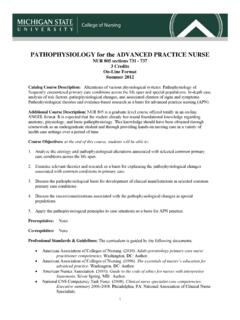Transcription of Implementation of the Integrated System of …
1 Implementation of the Integrated System of primary and Community care : Team-based care through primary care Networks Guidance to Collaborative Services Committees December 2017. Implementation of the Integrated System of primary and Community care : Team-based care through primary care Networks Guidance to Collaborative Services Committees Contents Context .. 3. Background .. 3. Objective .. 3. primary care Networks, Patient Medical Homes, Urgent Family care Centres and their Role in the Integrated System of primary and Community care .. 4. Community Readiness and Prototype Selection Criteria.
2 5. Resources .. 6. Compensation Options Supporting Team Based care .. 6. Approach and 7. Summary of Next 7. Appendix A: primary care Network Core Attributes .. 8. Appendix B: Patient and Provider Value Proposition .. 9. Appendix C: PMH Commitments in Support of 10. Appendix D: Community Readiness and Interest .. 11. Appendix E: Description of Resources Available .. 14. Appendix F: Definition of Funding Models .. 15. Appendix G: Roles of Partner 17. Appendix H: Engaging with First Nations/Indigenous Communities .. 18. December 2017 2 / 18. Implementation of the Integrated System of primary and Community care : Team-based care through primary care Networks Guidance to Collaborative Services Committees Context This guidance document covers the Implementation of team based care through primary care Networks in support of an Integrated System of primary and Community care .
3 The first phase of Implementation will occur over the next 12-18 months of a three year period, with the recognition that primary and community care integration and redesign is a long term endeavor and System outcomes will take longer to achieve. The overall objective of health System transformation is to deliver care that is accessible, person and family- centered, culturally safe, effective in meeting population and patients' needs, coordinated, seamless and easy to understand for patients, family members and care providers, and that has appropriate access and support from hospital and diagnostic services (this System is referred to as the Target Operating Model as set out in policy direction).
4 Background primary and community care is a major component of the British Columbia health System , delivering over thirty million health care services each year to 's million residents, with a total expenditure of approximately $ billion. Nearly every British Columbian has contact with this part of the health care System each year. Results of previous patient attachment and service integration efforts achieved a number of improvements to primary care access provincially, including over one hundred thousand previously unattached British Columbians gaining access to a family physician. Despite these efforts, patient access to primary care and community care across the province is still a challenge and the demand for primary and community care services is exceeding current capacity.
5 The formation of divisions of family practice throughout the province has enabled better intra-professional support, and the opportunity to partner with health authority and community organizations to identify and address health care needs within the community. Furthermore, national and international evidence indicates the addition of interdisciplinary team members to the primary care team, along with supports that enable those teams to design and deliver optimal care , is a means to improve both patient access to primary care and overall quality of care . The Ministry of Health, Doctors of BC and Health Authorities are committed to a vision that enables access to quality primary health care , including Urgent Family care Centres, that effectively meets the needs of patients and populations in BC, using the Patient Medical Home and primary care Network to form the foundation for care delivery within a broader, Integrated System of primary and Community care .
6 Additionally, within this System of care , it will be important to consider how best to coordinate care with specialist physicians to effectively meet patient needs. Objective To substantively implement team-based primary and community care through the Integrated System of primary and Community care (see Ministry of Health draft policy direction) across all 89 Local Health Areas (LHAs) and their constituent communities over the next three years, built on: - Increasing the availability of primary care teams through Patient Medical Homes (PMH). and Urgent Family care Centres. Teams will include doctors, nurse practitioners and nurses, and other health professionals linked to primary care networks, to ensure there December 2017 3 / 18.
7 Implementation of the Integrated System of primary and Community care : Team-based care through primary care Networks Guidance to Collaborative Services Committees are enough of the right type of services for the people who need them, and that they are available when they need them. - Establishing new Urgent Family care Centres in communities of greatest need with the full support of a medical team linked to lab and diagnostic services as part of the Integrated System of care . - Supporting GP practices to attain the attributes of the PMH, including a clear understanding of their patient panel, the ability to use practice level data to inform practice improvements, and the commitment to provide access to comprehensive care using team based care and networking to care for the community.
8 - Developing health authority delivered or contracted 1. Mental Health and Substance Use Services, 2. Older Adult, Complex Medical and Frailty Services, 3. Cancer care Services, and, 4. Scheduled Surgical Services into four Integrated specialized programs effectively linked to PMHs/PCNs (which include Urgent Family care Centres). primary care Networks, Patient Medical Homes, Urgent Family care Centres and their Role in the Integrated System of primary and Community care As outlined in the Ministry of Health (the Ministry) policy papers, primary care Networks (PCNs) will be established across BC to provide quality team based primary care services to the population of local communities, coordinating access to health authority specialized services through integration and service redesign.
9 A PCN is a network of family practices (including traditional GP owned family practices, community governed health centres, and health authority delivered family practices) in a defined geography linked with each other and with other primary care services delivered by the health authority and other community-based organizations. Patient Medical Homes (PMHs) are advanced primary care clinics that are defined by 12 attributes. Key attributes of PMHs include the provision of timely access to comprehensive, coordinated primary care which will require a focus on the following building blocks: engaged leadership, data-driven quality improvement, panel assessment and management, and team-based care .
10 Where established, Urgent Family care Centres may act as a key hub within a PCN to provide access to urgent care , extended hours and cover off for other practices, and access to a wider range of health care professionals While PMH and PCN, are the foundation of the Integrated System , true integration between primary care and health authority specialized services is essential to meet the needs of British Columbians and deliver the Triple Aim: improved patient and provider experience, improved population health, and reduced per capita cost of health care (also known as the Quadruple Aim). The objective of the first phase of primary and community care Implementation is to increase the number of British Columbians who have access to quality primary care and are attached to a primary care provider and establish formal linkages to efficient health authority managed, population based specialized services.









